Migrant cultural diversity and school curriculum in Language and Communication from 1st to 6th grade: distances and proximities
Main Article Content
Abstract
The presence of students of migrant origin in Chilean classrooms is a growing reality, which stresses the role attributed to the national curriculum in its attempt to offer a common cultural base. Considering this tension, the study proposes to read critically, the Curricular Bases and Language and Communication study programs from 1st to 6th grade. Through a methodology of documentary analysis and the technique of qualitative content analysis, the objective is to evaluate the proximity and distances that the official curriculum of the area establish in relation to the subject of migration. The results show a greater predominance of curricular distances, which respond to an exercise of exclusion of migrant cultural diversity due to the monocultural hegemony of the curriculum. In as much, the curricular bases, study programs, culture, migration.

